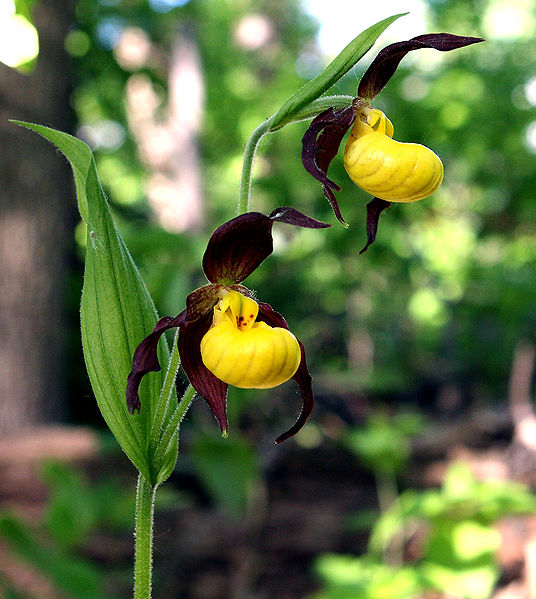Reproduction
The reproduction of Cypripedium
parviflorum is very unique and representative of the orchid
family. Through the seeds and seed dispersal, the life cycle of
the Yellow Ladyslipper Orchid is complicated and very site
specific. Weather conditions, soil conditions and organisms must
all be correct for this flower to blossom, and even then that
requires a great deal of patience from the observer. Germination
usually requires about six months and after that, on average of
the specimens studied in Wisconsin, have a time span of
approximately twelve (12) years from germination before blooming
is seen.
C. parviflorum has a special
kind of flower termed a “trap flower”. This
flower’s morphology (appearance) is designed to trap insects inside the
flower, leaving only a few paths to escape, all of which have anthers (which
are coated in pollen) at the exit that the insect must rub against to pick
up pollen. Then, on the way into another flower, the insect brushes against
the stigma of that flower and hopefully pollinates the flower.
Pollination:
The Yellow Ladyslipper Orchid uses insects to
pollinate themselves. The flowers do produce nectar to attract the insects;
however they often play tricks and use oil instead of nectar when the insect
comes to feast. The insects come to eat hair like structures (trichomes)
that they believe contain nectar, however there is only an oil in there, and
their body becomes a pollen carrier as they go off in search of a new tasty
treat. After a carrier goes through the trap flower concept and pollinates
the flower, time elapses (approximately 30 days depending on environmental
conditions) before the flower is actually fertilized.
Seed Morphology and Dispersal:
A unique characteristic to orchids is their seed
morphology. The seeds are very small, high in count and light weight to be
easily transported. Some seeds have been recorded to travel 60 to 900 miles
from the closest plant. Yellow Ladyslipper seeds have a very tough outer
coating that takes soil organisms upwards of six months to break through and
allow germination. The seeds are very picky about what soil they are in, due
to the fact that the seed requires a symbiotic relationship with a
mycorrhizal fungus in the beginning of its life cycle. Orchid seeds are not
built to sustain themselves alone, so a fungus will come in during the
protocorm phase of the life cycle (see summary below) and supply nutrients
to the newly growing plant. These nutrients may come from decomposing
substances in the substrate or they may come from living trees around the
plant.
 Seeds are more than likely dispersed by either
wind or water. The transportation by wind is validated by the seed
morphology. There are light weight airy sections of the seed as well as a
broad flat shape with a rough texture to increase surface area for the wind
to propel the seed. The water transportation is validated through the
behavior of the seed pod as well as the seed coating. The seed coating is
water resistant as well as rough and broad to catch more water current,
making water a perfect medium for transportation. The seed pod behavior also
favors water, as it opens when it is wet and seals tight when dry.
Seeds are more than likely dispersed by either
wind or water. The transportation by wind is validated by the seed
morphology. There are light weight airy sections of the seed as well as a
broad flat shape with a rough texture to increase surface area for the wind
to propel the seed. The water transportation is validated through the
behavior of the seed pod as well as the seed coating. The seed coating is
water resistant as well as rough and broad to catch more water current,
making water a perfect medium for transportation. The seed pod behavior also
favors water, as it opens when it is wet and seals tight when dry.
Overview of the Early Growth Stages and
General Life Cycle:
·
Insect vector picks up pollen
·
Insect pollinates second flower
·
Embryo develops and seeds are released
·
Seed lands in soil conditions for up to six months waiting for soil organism
to break down seed coat for germination to occur.
**For germinated seed to survive, a symbiotic
relationship with a fungus must be formed with a mycorrhizal fungus.
·
Protocorm stage: stage from germination until seedling has
developed a shoot tip with leaves but no true roots (rhizomes in place of
roots)
·
Mycorrhizome stage: rhizomes form the symbotic relationship
with the fungus and true roots begin to form. Lots of phloem development.
·
Roots ocontinue to grow for up to five years with major xylem development
·
First leaf will appear anywhere from the first year to the fourth year after
germination occurs
· As
the plant continues to gain foliage, dependency on the fungus to survive
will decrease or all together disappear

